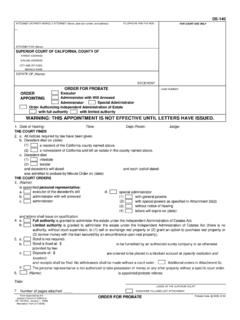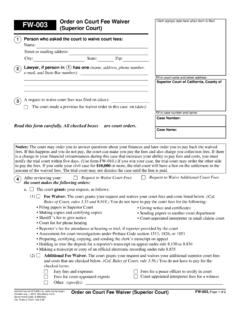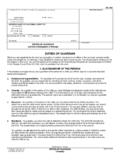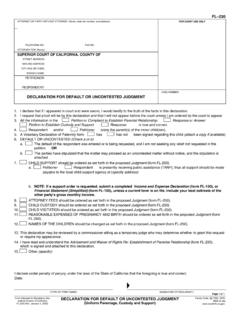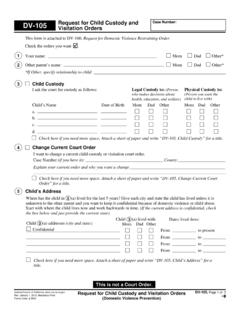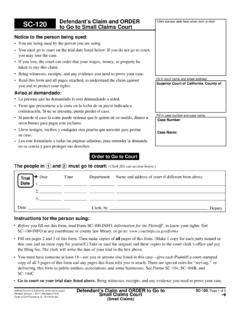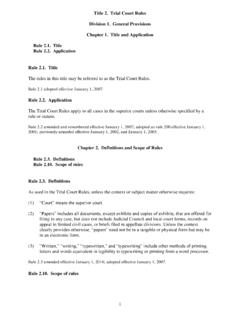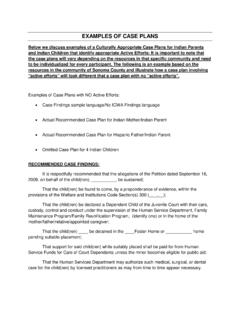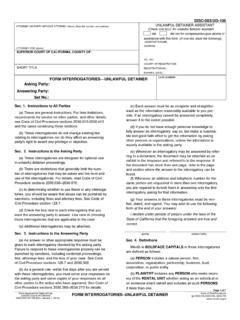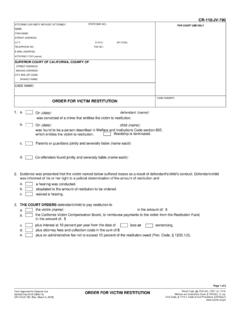Transcription of 2017 Court Statistics Report - California
1 2017 Court Statistics REPORTS tatewide Caseload Trends2006 2007 Through 2015 20162017 Court Statistics REPORTS tatewide Caseload Trends 2006 2007 Through 2015 2016 Judicial Council of California455 Golden Gate AvenueSan Francisco, California 94102-3688415-865-7740 California Courts Infoline: 2017 by Judicial Council of California . All rights as permitted under the Copyright Act of 1976 and as otherwise expressly provided herein, no part of this publication may be reproduced in any form or by any means, electronic, online, or mechanical, including the use of information storage and retrieval systems, without permission in writing from the copyright holder. Permission is hereby granted to nonprofit institutions t o reproduce and distribute this publication for educational purposes if the copies credit the copyright Report is available on the California Courts website.
2 #id7495 JUDICIAL COUNCIL OF California Mart in HosHinoAdministrative DirectorJody Pat elChief of StaffAdministrative DivisionJoHn WordlaWChief Administrative OfficerBudget ServicesZlat ko tHeodorovicDirectorlucy FogartyDeputy DirectorOffice o f Court ResearchleaH rose-goodWinManagercHr is Bel lol iSupervising Research AnalystcHery l kingResearch AnalystMatt HeW clarkAssociate Analystnoor singHAssociate AnalystPR E FA C E Court Statistics Report The Court Statistics Report (CSR) is published annually by the Judicial Council of California and is designed to fulfill the provisions of article VI, section 6 of the California Constitution, which requires the Judicial Council to survey the condition and business of the California Courts. The CSR combines 10-year statewide summaries of Superior Court filings and dispositions with similar workload indicators for the California Supreme Court and Courts of Appeal.
3 The 2017 CSR also provides more detailed information on filings and dispositions in the individual Superior Courts for the most recent fiscal year for which data are available, 2015 2016. Caseload Data and Court Workload California s Court system is one of the largest in the world and serves a population of more than 39 million people about 12 percent of the total population and more than 2,000 judicial officers and approximately 19,000 Judicial Branch employees statewide address the full range of cases heard each year. The vast majority of cases in the California Courts begin in one of the 58 superior, or trial, courts, which reside in each of the state s 58 counties. With more than 500 Court buildings throughout the state, these courts hear both civil and criminal cases as well as family, probate , mental health, juvenile, and traffic cases. The data published in the Court Statistics Report is used by the Judicial Branch in policy development, program evaluation, performance management, and in workload analysis to measure judicial and Court staff resource needs in California .
4 Because different types of cases require different amounts of judicial and staff resources, a weighted caseload approach is the standard method, nationwide, to estimate the workload and resource needs of the courts. Weighted caseload distinguishes between different categories of filings so that the resources required to process a felony case, for example, are recognized as being much greater than the resources required to process a traffic infraction. As the mix or composition of cases change over time, a weighted caseload approach is needed to assess the impact of caseload trends on Court workload. The Judicial Council has adopted caseweights for two workload models used by the Judicial Branch the Judicial Workload Assessment and the Resource Assessment Study (RAS) model. With the introduction of a new budget development and allocation process for the trial courts in 2013, the data published in the Court Statistics Report is being used by the Judicial Branch for a critically important new purpose.
5 The Judicial Council adopted the Workload-based Allocation and Funding Methodology, or WAFM, which uses the Resource Assessment Model (RAS) and other workload factors in a new budget development process that alters baseline funding for most trial courts based on Court workload. Summary of 2017 Court Statistics Report A summary of the caseload data in the 2017 CSR for the California Supreme Court , Courts of Appeal, and Superior Courts for fiscal year 2015 2016 are as follows: Supreme Court The Supreme Court issued 76 written opinions during the year. Filings totaled 8,079, and dispositions totaled 7,946. Automatic appeals arising out of judgments of death totaled 8 cases, and the Court disposed of 23 such appeals by written opinion. The Supreme Court ordered 17 Court of Appeal opinions depublished in this fiscal year. Courts of Appeal Total contested matters for the Courts of Appeal totaled 20,217 made up of 13,296 records of appeal and 6,921 original proceedings.
6 Dispositions in the Courts of Appeal totaled 22,931. Of these dispositions, 16,012 were appeals, and 6,919 were original proceedings. Dispositions of appeals by written opinion totaled 9,967, appeals disposed of without written opinion totaled 4,000, and appeals disposed of without a record filed totaled 2,045. Dispositions of original proceedings by written opinion totaled 420, and original proceedings disposed of without written opinion totaled 6,590. Statewide, 8 percent of Court of Appeal majority opinions were published. Superior Courts In FY 2015-16, over million cases were filed statewide in the Superior Courts. The CSR organizes all the cases filed in the courts in four main case categories Civil; Criminal; Family and Juvenile; probate , Mental Health, Appeals, Habeas. The case filing totals for the individual case types reported by the courts for FY 2015-16 are as follows: Civil: The civil case category is made up of unlimited civil, limited civil, and small claims matters.
7 Civil unlimited cases are matters where the petitioner is seeking more than $25,000. There were 201,390 unlimited civil cases filed in the courts. Limited civil filings are cases where the petitioner is seeking $25,000 or less. Limited civil cases totaled 352,562 statewide. Small claims filings are cases where the petitioner is seeking $10,000 or less and is not represented by counsel. A total of 158,347 small claims cases were filed statewide. Criminal: The criminal case category is made up of felonies, misdemeanors, and infractions. The filing totals for the individual case types are as follows: felony filings represented 200,200 cases, misdemeanor filings totaled 841,716 cases, and infraction filings accounted for 3,904,965 cases. Family and Juvenile: Marital filings (dissolutions, legal separations and nullities) accounted for 138,520 cases and other family law filings ( paternity, child support) totaled 249,329 cases.
8 Juvenile delinquency filings totaled 35,287 cases and juvenile dependency filings totaled 43,674 cases. probate , Mental Health, Appeals, and Habeas: The filing totals for the individual case types are as follows: probate filings totaled 47,170 cases; mental health filings totaled 33,154 cases; civil and criminal appeal filings totaled 4,321 cases; and criminal habeas corpus filings totaled 7,165 cases. The million cases filed statewide in the Superior Courts in FY 2015-16 represented a 9 percent decline over the past year. This decline was driven mostly by limited jurisdiction cases such as criminal infractions and traffic matters that tend to be, on average, much less complex and resource-intensive for courts. These criminal infractions and traffic matters make up a significant proportion of overall Court caseload, or total filings, but only have a minor impact on the overall workload for Superior Courts.
9 When these criminal infractions and traffic cases are excluded from the analysis, there was a small increase of 1 percent in total non-infraction, non-traffic filings over the past year. And several of the most complex types of cases contributed to this increase in non-infraction, non-traffic filings from the previous year, which include Personal Injury/Property Damage/Wrongful Death (PI/PD/WD), Family Law, probate , and Mental Health. C O N T E N T S Preface .. 4 Introduction .. 14 The California Court System .. 20 SUPREME Court .. 26 Total Filings and 28 Figure 1 Total Filings .. 28 Figure 2 Total Dispositions .. 28 Filings and Dispositions: Summary .. 29 Figure 3 Petitions for Review .. 29 Figure 4 Original Proceedings .. 29 Figure 5 Automatic Appeals .. 29 Figure 6 Habeas Corpus Related To Automatic Appeals .. 29 Figure 7 State Bar Matters.
10 29 Data for Figures 3 7: Filings and Dispositions: Summary .. 30 Filings and Dispositions: Petitions for Review .. 31 Figure 8 Total Petitions for Review .. 31 Figure 9 Civil Total .. 31 Figure 9a Civil Appeals .. 31 Figure 9b Civil Writs .. 31 Figure 10 Criminal Total .. 31 Figure 10a Criminal Appeals .. 31 Figure 10b Criminal Habeas Corpus .. 31 Figure 10c Criminal Other Writs .. 31 Data for Figures 8 10c: Filings and Dispositions: Petitions for 32 Summary of Actions on Petitions for Review .. 33 Table 1 Summary of Actions on Petitions for Review .. 33 Filings and Dispositions: Original Proceedings .. 34 Figure 11 Total Original Proceedings .. 34 Figure 12 Civil Total .. 34 Figure 13 Criminal Total .. 34 Figure 13a Criminal Habeas Corpus .. 34 Figure 13b Criminal Other Writs .. 34 Data for Figures 11 13b: Filings and Dispositions: Original Proceedings.
